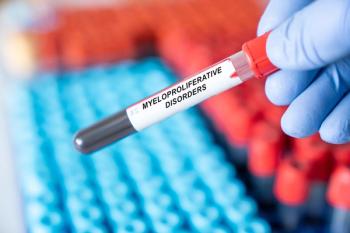
Genetic Testing for Hereditary Cancer Identifies Case of MDS
Key Takeaways
- Personalized treatment strategies are increasingly important in managing lung cancer brain metastases, incorporating targeted therapies and immunotherapies.
- Stereotactic radiosurgery and whole-brain radiation therapy are evolving with new systemic therapies, offering less invasive options.
Genetic testing for hereditary cancer unexpectedly uncovers a case of myelodysplastic syndrome (MDS), highlighting the need for careful interpretation of results and multidisciplinary collaboration.
Routine genetic testing for hereditary cancer risk led to an unexpected diagnosis of
“To our knowledge, the diagnosis of MDS through hereditary cancer genetic testing has not been previously reported,” the authors wrote. “Here we describe a case where genetic testing for hereditary forms of solid tumors on PBLs [peripheral blood leukocytes] revealed an unsuspected diagnosis of MDS, underscoring the importance of considering hematologic conditions when interpreting genetic test results.”
The patient, who had previously been diagnosed with 3 distinct solid tumors—Ewing’s sarcoma at age 16, breast cancer at age 53, and papillary thyroid cancer at age 57—and had a significant family history of cancer, underwent germline genetic testing using next-generation sequencing (NGS) with a 76-gene panel for hereditary cancer syndromes. PBLs were used as the DNA source for initial testing, and the results showed full-gene deletions in APC and CTNNA1. This finding suggested a contiguous deletion of chromosome 5, or del(5q), which is commonly associated with hematological malignancies such as MDS.
“Hereditary cancer panel testing may offer further observations that are outside of the original reason for testing,” the authors wrote. “Multiple gene deletions on germline panels, for example, could demonstrate larger cytogenetic abnormalities that are not fully captured by NGS panel testing. The genes APC and CTNNA1 are often represented in multi-gene panels for common solid tumor syndromes and have also been known to play a role in the hematopoietic system and the pathogenesis of MDS.”
To determine whether the mutations were inherited or acquired, follow-up testing was conducted using DNA from a skin punch biopsy. The biopsy confirmed variants of uncertain significance in POT1 and MLH3 as germline, which were also seen in the PBL results, but the APC and CTNNA1 deletions were not present, suggesting the mutations were somatic rather than inherited.
A bone marrow biopsy confirmed the del(5q) chromosomal abnormality and MDS diagnosis. Hematologic measures showed a slightly low hemoglobin level (119 g/L), normal absolute neutrophil count, and normal platelet count.
The patient was classified as very low risk based on Molecular International Prognostic Scoring System grading. However, MDS can progress to acute myeloid leukemia, so early detection is key for improving clinical outcomes.2 This case exemplifies how germline testing intended to assess inherited cancer risk can incidentally uncover clonal hematopoiesis or blood disorders.1
“Our case demonstrates the implications of unknown hematologic disorders when germline genetic testing is performed on blood,” the authors wrote. “Although there is consensus that peripheral blood should not be used for germline genetic testing in individuals diagnosed with a hematologic condition such as MDS, there remains a challenge in the unknown presence of hematologic disorders.”
Somatic variants present in blood cells may be mistakenly interpreted as germline mutations, potentially misleading clinicians. In their case study, a del(5q) was seen in blood but was not present in cultured fibroblasts, the authors explained. “Without further recommendations from a genetic counselor to obtain a secondary DNA sample, there is a hypothetical risk of misinterpreting the initial results.”
They also noted that a complete blood count is often not done prior to genetic testing using PBL, and in some hematologic conditions, like clonal hematopoiesis of indeterminate potential, blood counts are normal.
“Therefore, we emphasize the value of close collaboration with genetic counselors, laboratory geneticists, oncologists, and pathologists when reviewing and interpreting genetic testing reports, as further investigations may be warranted,” the authors concluded.
References
1. Ridd S, Peck L, Bankar A, et al. Myelodysplastic syndrome diagnosed by genetic testing for hereditary cancer: a case report. NPJ Genom Med. Published online May 15, 2025. doi:10.1038/s41525-025-00476-6
2. Bănescu C, Tripon F, Muntean C. The Genetic Landscape of Myelodysplastic Neoplasm Progression to Acute Myeloid Leukemia. Int J Mol Sci. 2023;24(6):5734. doi:10.3390/ijms24065734
Newsletter
Stay ahead of policy, cost, and value—subscribe to AJMC for expert insights at the intersection of clinical care and health economics.













































